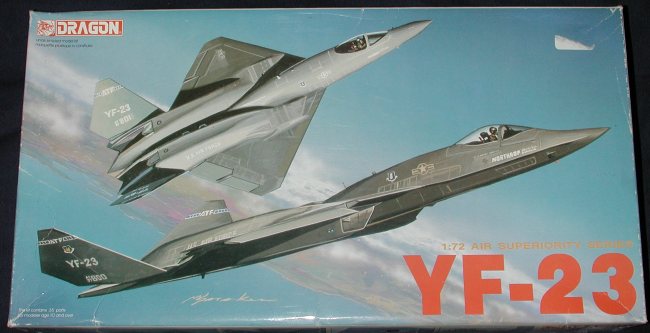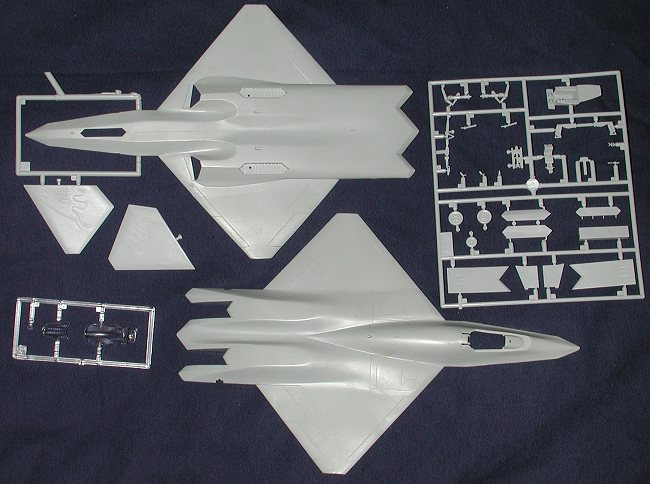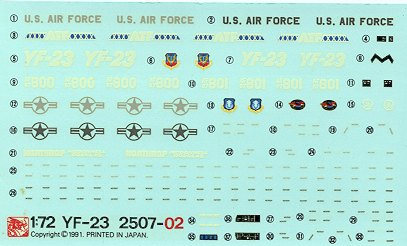
| KIT: | Dragon 1/72 YF-23 |
| KIT # | 2507 |
| PRICE: | $? |
| DECALS: | Two aircraft |
| REVIEW & | |
| NOTES: | Kit currently OOP (Feb 2001) |

| HISTORY |
Back over ten years ago, the USAF was looking for a replacementfor its F-15 Eagle. Such is the state of modern military aviation that it takesa long lead time to get a new aircraft into production. There are a number ofreasons for this. First of all, equipment tends to stay in service for a muchlonger period of time than 50 years ago. The F-100 was in service for 20 years,the F-4 for over 30 and the F-15 has been around for 25 years with a bunch moreto go.
Aircraft also cost a lot more than they used to, so it isexpected that they be around for a long time. It is rare that an airframe doesnot undergo a major avionics change about half way through its useful lifespan.Avionics make it practically a new aircraft. Technology is such that developinga new plane is time consuming and often quite difficult. Test aircraft oftenshow problems that result in pre-production and production aircraft beingdifferent from the prototypes. Such is the case of the YF-22 vs the F-22A thatis just now in pre-production, over ten years after the prototype first flew.
During the most recent fighter competition, there were twoaircraft up for the honors of supplanting the Eagle. One was the YF-22, whichwon the competition; the other the YF-23. This aircraft is, to me, a much coolerlooking and stealthier aircraft than the rather squat F-22. In fact, there wasdarn little to chose between the two. Both of them were able to meet or exceedthe requirements set out. There were two prototypes of each plane, each withdifferent engines. Despite the equality in performance, the YF-22 was chosen.Though many will bemoan the fact that Northrop is usually dumped on and claimbias to the Lockheed aircraft, the fact is that the F-22 would be easier tobuild and therefore cheaper per unit. The two YF-23 prototypes are still extantat Edwards AFB and though not flown in a long time, I understand that one is tobe uses for some sort of flight testing. Any additional info would beappreciated.
| THE KIT |

Dragon has been well known for kits that look great in the box,but are the dickens to build. Well, I can tell you from experience that this kitis not that way. Basically it is a very simple model, as you can see. Most ofthe plastic is in the upper and lower fuselage halves. There are no optionsother than canopy open or closed and decal choice. No opening weapons bay or anyother goodies. Basically one sticks the baffles into the fuselage as well as theinterior. Glue the fuselage halves together, and stick on the landing gear anddoors. That's it!
 The kit itselfhas the required engraved panel lines. The cockpit tub is nice enough withraised detailing on the side consoles and instrument panel. Decals are alsogiven for these areas if you so choose. There is also a stick and seat. The seatlooks like an Aces seat so you may want to replace it with an aftermarketone....or not. You will need to put weight in the nose; actually, a lot of it asit is a tail heavy model.
The kit itselfhas the required engraved panel lines. The cockpit tub is nice enough withraised detailing on the side consoles and instrument panel. Decals are alsogiven for these areas if you so choose. There is also a stick and seat. The seatlooks like an Aces seat so you may want to replace it with an aftermarketone....or not. You will need to put weight in the nose; actually, a lot of it asit is a tail heavy model.
Instructions are very good and up to industry standards. Paintsreferenced are Gunze and FS 595 standards are given as needed. There are twocamo schemes; a light grey one and an 'F-15' sort of scheme. One is for the GEengined plane and the other for the Pratt and Whitney engined version.
Construction is really very straightforward and is simple enoughthat just about any modeler can produce a super model from this kit. The onlyproblem will be finding one. Over the last few years it has become a bit toughto find.
Review kit courtesy of me and my wallet!
If you would like your product reviewed fairly and quickly by asite that has over 1,800 visits a day, please contactme or see other details in the